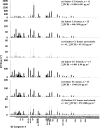Inhalation and dietary exposure to PCBs in urban and rural cohorts via congener-specific measurements
- PMID: 25510359
- PMCID: PMC4303332
- DOI: 10.1021/es5048039
Inhalation and dietary exposure to PCBs in urban and rural cohorts via congener-specific measurements
Abstract
Polychlorinated biphenyls (PCBs) are a group of 209 persistent organic pollutants, whose documented carcinogenic, neurological, and respiratory toxicities are expansive and growing. However, PCB inhalation exposure assessments have been lacking for North American ambient conditions and lower-chlorinated congeners. We assessed congener-specific inhalation and dietary exposure for 78 adolescent children and their mothers (n = 68) in the Airborne Exposure to Semi-volatile Organic Pollutants (AESOP) Study. Congener-specific PCB inhalation exposure was modeled using 293 measurements of indoor and outdoor airborne PCB concentrations at homes and schools, analyzed via tandem quadrupole GS-MS/MS, combined with questionnaire data from the AESOP Study. Dietary exposure was modeled using Canadian Total Diet Survey PCB concentrations and National Health and Nutrition Examination Survey (NHANES) food ingestion rates. For ∑PCB, dietary exposure dominates. For individual lower-chlorinated congeners (e.g., PCBs 40+41+71, 52), inhalation exposure was as high as one-third of the total (dietary+inhalation) exposure. ∑PCB inhalation (geometric mean (SE)) was greater for urban mothers (7.1 (1.2) μg yr(–1)) and children (12.0 (1.2) μg yr(–1)) than for rural mothers (2.4 (0.4) μg yr(–1)) and children (8.9 (0.3) μg yr(–1)). Schools attended by AESOP Study children had higher indoor PCB concentrations than did homes, and account for the majority of children’s inhalation exposure.
Figures




References
-
- Espandiari P.; Glauert H. P.; Lehmler H. J.; Lee E. Y.; Srinivasan C.; Robertson L. W. Polychlorinated biphenyls as initiators in liver carcinogenesis: Resistant hepatocyte model. Toxicol. Appl. Pharmacol. 2003, 186155–62. - PubMed
-
- Harper N.; Connor K.; Steinberg M.; Safe S.. Immunosuppressive activity of polychlorinated biphenyl mixtures and congeners: Non-additive (antagonistic) interactions. Fundam. Appl. Toxicol. 199527(131). - PubMed
Publication types
MeSH terms
Substances
Grants and funding
LinkOut - more resources
Full Text Sources
Other Literature Sources

